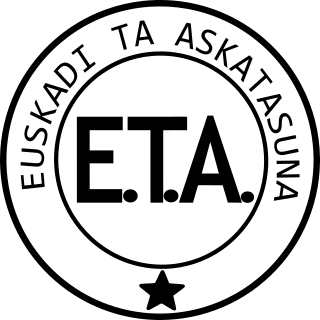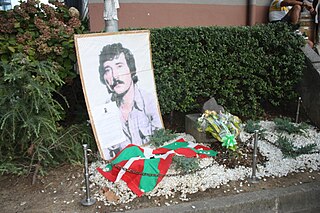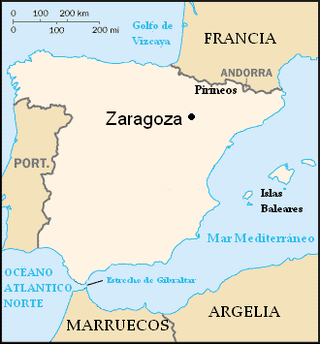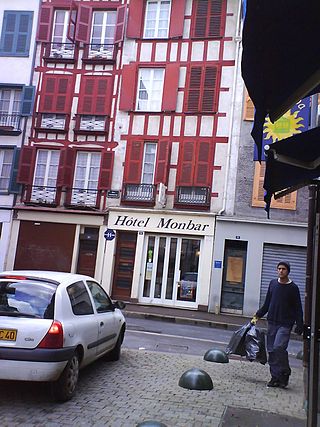Related Research Articles

ETA, an acronym for Euskadi Ta Askatasuna, was an armed Basque nationalist and far-left separatist organization in the Basque Country between 1959 and 2018, with its goal being independence for the region. The group was founded in 1959 during the era of Francoist Spain, and later evolved from a pacifist group promoting traditional Basque culture to a violent paramilitary group. It engaged in a campaign of bombings, assassinations, and kidnappings throughout Spain and especially the Southern Basque Country against the regime, which was highly centralised and hostile to the expression of non-Castilian minority identities. ETA was the main group within the Basque National Liberation Movement and was the most important Basque participant in the Basque conflict.

GAL were death squads illegally established by officials of the Spanish government to fight against ETA, the principal Basque separatist terrorist group. They were active from 1983 to 1987 under Spanish Socialist Workers' Party (PSOE)-led governments.

On 30 December 2006, a van bomb exploded in the Terminal 4 parking area at the Madrid–Barajas Airport in Spain, killing two and injuring 52. On 9 January 2007, the Basque nationalist and separatist organisation ETA claimed responsibility for the attack. The attack, one of the most powerful carried out by ETA, damaged the airport terminal and destroyed the entire parking structure. The bombing ended a nine-month ceasefire declared by the armed organisation and prompted the government to halt plans for negotiations with the organisation. Despite the attack, ETA claimed that the ceasefire was still in place and regretted the death of civilians. The organisation eventually announced the end of the ceasefire in June 2007.
ETA's 2006 "permanent ceasefire" was the period spanning between 24 March and 30 December 2006 during which, following an ETA communiqué, the Spanish government, led by José Luis Rodríguez Zapatero on one side, and the militant group on the other, engaged in talks as a means to agree on a formula to voluntarily disband the latter. It was terminated as a result of the 2006 Madrid Barajas International Airport bombing.

A car bomb attack was carried out on 19 June 1987 at the Hipercor shopping centre in Barcelona, Spain, by the Basque separatist organisation ETA, which was classified as a terrorist group. The bombing killed 21 people and injured 45, the deadliest attack in ETA's history. Controversy surrounded the timing of telephone warnings made before the attack and the authorities' response to them.

The Basque conflict, also known as the Spain–ETA conflict, was an armed and political conflict from 1959 to 2011 between Spain and the Basque National Liberation Movement, a group of social, terrorist and political Basque organizations which sought independence from Spain and France. The movement was built around the terrorist organization ETA, which had launched a campaign of attacks against Spanish administrations since 1959. ETA had been proscribed as a terrorist organization by the Spanish, British, French and American authorities at different moments. The conflict took place mostly on Spanish soil, although to a smaller degree it was also present in France, which was primarily used as a safe haven by ETA members. It was the longest running violent conflict in modern Western Europe. It has been sometimes referred to as "Europe's longest war".

A van bomb went off on 19 May 2008 outside a boat club in the town of Getxo, Biscay in the Basque Country, Spain. The attack caused serious damage to the club, as well as nearby buildings and structures. No one was killed or injured after a warning call from the Basque separatist organisation ETA. On 31 May, the organisation claimed responsibility for the bombing.

The Cafetería Rolando bombing was an attack on 13 September 1974 at the Rolando cafe in Calle del Correo, Madrid, Spain which killed 13 people and wounded 71. Though no claim of responsibility was made, the attack is widely believed to have been carried out by the armed Basque separatist group ETA.

A car bomb attack was carried out by the Basque separatist organisation ETA on 11 December 1987. A vehicle containing 250 kilograms (550 lb) of ammonal was parked beside the main Guardia Civil barrack headquarter in the city of Zaragoza, Aragon, Spain; its subsequent explosion killed 11 people, including 5 children. Another 88 people were injured, the majority of them civilians.
A car bomb attack was carried out by the armed Basque separatist group ETA in Madrid, Spain, on 14 July 1986, which killed 12 people and injured another 32. The dead were all members of the Guardia Civil studying in the nearby traffic school on Príncipe de Vergara. The ETA members later convicted of participation in the attack included significant figures in the group, including Antonio Troitiño and Iñaki de Juana Chaos.
The July 1979 Madrid bombings were a series of bomb attacks carried out by ETA political-military (ETA-pm), a faction of the armed Basque separatist group ETA. The attacks, consisting of coordinated bombings in Barajas Airport and the train stations of Atocha and Chamartín, killed 7 people and injured a further 100. The bombings occurred a day after two attacks in Bilbao and San Sebastian, with both attacks killing two people.
The 1980 Zarautz attack was a mass shooting gun attack by the Basque separatist organisation ETA which occurred on 3 November 1980 in the Basque town of Zarautz in Gipuzkoa. The targets were several off duty civil guards belonging to the traffic department, who were drinking in a bar in the town. The attack was the second deadliest of 1980, the year when ETA killed more people than any other.
The September 1982 Rentería attack was an ambush by the Basque separatist organisation ETA which occurred on 14 September 1982 on the motorway near the Basque town of Errenteria in Guipuzkoa. The targets were several national police officers, four of whom were killed in the attack, with the fifth seriously injured. The attack was ETA's deadliest of 1982.
A car bombing was carried out by the Basque separatist organisation ETA on 16 September 1991 in the town of Mutxamel near Alicante. The target was the Civil Guard barracks in the town. However the bomb initially failed to explode near its target. The police treated the car as an abandoned vehicle, not realising that it contained a bomb and while being towed away, the car bomb exploded, killing two police officers and the civilian towing the car away. The bombing was the deadliest of the 40 attacks which ETA carried out in the Province of Alicante between 1979 and 2004.
A car bomb attack was carried out by the armed Basque separatist group ETA in the Puente de Vallecas district of Madrid, Spain on 11 December 1995, which killed 6 people and injured a further 19. The target was a camouflaged army vehicle which was transporting nine civilian employees of the army towards the nearby motorway.
Car bomb attacks were carried out by the armed Basque separatist group ETA in Madrid, Spain on 21 June 1993, killing 7 people and injuring a further 29. The target was an army vehicle transporting members of the army. The dead included four lieutenant colonels, a commander, a sergeant and the civilian driver of the vehicle. This was ETA's deadliest attack of 1993.

A car bombing was carried out by the armed Basque separatist group ETA in Sabadell, Catalonia, Spain on 8 December 1990.

The Monbar Hotel attack was carried out by the Grupos Antiterroristas de Liberación (GAL), a Spanish state-sponsored death squad, on 25 September 1985 in Bayonne, Pyrénées-Atlantiques, France. The targets were four members of the Basque separatist terrorist group Euskadi Ta Askatasuna (ETA), whom the Spanish government believed to be senior figures in the organization, itself proscribed as a terrorist group in Spain and France. All four people were killed, with a fifth person, apparently unconnected to ETA, injured in the shooting. This represented the deadliest attack carried out by the GAL. Although two of the participants were apprehended shortly after the shooting, controversy surrounded the possible involvement of senior figures in the Spanish police.
The 1980 Orio ambush was a gun and grenade attack by the Basque separatist organisation ETA which occurred on 13 July 1980 near the Basque town of Orio. The targets were a convoy of civil guards who had just finished their shift guarding the nearby munitions factory. Two civil guards were killed and three injured, while two ETA members were killed after the civil guards starting the new shift came to the assistance of their colleagues.
References
- ↑ Listado de asesinados por ETA facilitado por la Fundación Víctimas del Terrorismo Archived May 12, 2012, at the Wayback Machine , El Pais, accessed 14 April 2013
- ↑ Securing and Sustaining the Olympic City, Pete Fussey, Ashgate Publishing, 2011, p48
- ↑ Historical Dictionary of Modern Olympic Movement, John E. Findling & Kimberly D. Pelle, Greenwood Publishing Group, 1996, p189
- 1 2 3 4 5 La Vanguardia, 7 February 1992, p6
- 1 2 La Vanguardia, 7 February 1992, p1